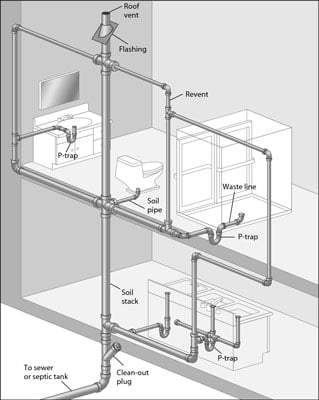How Proper Ventilation is Essential for Plumbing Systems
How Proper Ventilation is Essential for Plumbing Systems
Blog Article
Are you in search of selective information on The Upsides of Proper Ventilation in Plumbing Design?

Proper ventilation in plumbing systems is commonly forgotten, yet it is vital for keeping the functionality and safety and security of your home's plumbing. Air flow helps control air pressure, protect against the build-up of damaging gases, and make sure the efficient removal of waste. In this guide, we will discover the importance of appropriate plumbing air flow, how it works, and the advantages it gives your plumbing system.
Exactly How Ventilation Works in Pipes Solutions
Atmospheric Pressure Regulation
Correct ventilation preserves well balanced air pressure within the pipes system. When water flows through pipes, it displaces air. Without ample air flow, this displacement can produce adverse stress, bring about slow drains or siphoning of water from catches, which can cause undesirable smells to seep into the home.
Preventing Drain Gas Buildup
One of the most critical features of pipes vents is to stop sewage system gases, such as methane and hydrogen sulfide, from building up within the home. These gases can present major health and wellness dangers and are very flammable. Vent pipelines permit these gases to escape safely outdoors.
Assisting in Waste Elimination
Air flow aids in the effective elimination of wastewater by avoiding airlocks in the drain system. When air can move openly through the vents, it permits water and waste to stream smoothly through the pipes, lowering the danger of clogs and backups.
Benefits of Proper Ventilation
Boosted System Effectiveness
Appropriately ventilated plumbing systems operate a lot more efficiently, with less clogs, faster draining pipes, and less strain on the pipes. This performance prolongs the lifespan of the pipes system.
Improved Air High Quality
By stopping sewer gases from entering your home, correct ventilation contributes to far better indoor air top quality, making your living atmosphere healthier and a lot more comfy.
Protecting Against Water Damages
Sufficient air flow assists stop water from being siphoned out of catches, which can lead to sewer gases going into the home and creating water damages over time.
Actions to Guarantee Proper Air Flow
Consulting Plumbing Codes
Always speak with regional pipes codes when making or modifying your pipes system. These codes offer the required guidelines for proper venting and guarantee your system meets safety and security requirements.
Regular Examination and Maintenance
Routine examinations can assist recognize possible ventilation issues before they come to be major troubles. Maintenance tasks, such as cleaning up air vent pipelines and checking for clogs, are crucial for keeping the system in good working order.
Expert Installment
For brand-new installations or major modifications, it's smart to work with a professional plumbing technician. They have the proficiency to guarantee the ventilation system is correctly designed and installed according to code.
Understanding Air Flow in Pipes
Ventilation in plumbing describes the network of pipes that permit air to move through the drainage system. These vents serve multiple objectives, consisting of regulating air pressure within the pipelines, preventing sewer gases from entering the home, and helping in the smooth circulation of wastewater.
Kinds Of Plumbing Vents
Main Stack Vent
The major stack vent, also called the vent pile, is the primary air vent in a plumbing system. It prolongs from the main drain align through the roofing, allowing gases to get away and fresh air to get in the system.
Branch Vent
Branch vents connect to the primary pile air vent and offer specific components, such as sinks, commodes, and showers. These vents ensure that each fixture has sufficient ventilation to work correctly.
Air Admittance Shutoff (AAV).
An Air Admittance Valve (AAV) is a one-way shutoff that enables air to enter the pipes system without the requirement for a typical air vent pipeline expanding with the roofing. AAVs are generally utilized in restorations or areas where installing a basic air vent is unwise.
Signs of Poor Ventilation in Pipes.
Slow Draining Fixtures.
If your sinks, bathtubs, or toilets are draining pipes slowly, maybe an indication of poor ventilation. Insufficient air flow can create a vacuum cleaner impact, making it hard for water to drain pipes correctly.
Gurgling Appears.
Gurgling sounds coming from drains pipes are commonly an outcome of air being drawn via water traps because of adverse pressure in the pipelines. This is a clear indication of inadequate ventilation.
Undesirable Smells.
Sewage system odors inside your home are a warning that your pipes system is not appropriately ventilated. This might mean that sewage system gases are not being properly vented outside, bring about potentially harmful conditions.
Typical Ventilation Errors.
Inadequate Vent Sizing.
Making use of undersized air vent pipelines can lead to inadequate air circulation and pressure imbalances in the system. It's important to make use of vents that meet the specific requirements of your plumbing system.
Improper Vent Positioning.
Putting vents too far from the components they offer can minimize their effectiveness. Appropriate positioning ensures that air can stream freely and effectively via the system.
Ignoring Code Requirements.
Building codes give details standards for pipes air flow. Ignoring these codes can result in a system that stops working to operate appropriately and might lead to costly repair work or health hazards.
Final thought.
Appropriate ventilation is an essential part of any kind of plumbing system, making certain that it operates successfully and securely. By comprehending the significance of air flow, acknowledging the signs of inadequate air flow, and taking steps to keep your system, you can prevent costly issues and protect your home's air top quality.
4 Things You Should Know About Your Plumbing Vents
What Plumbing Vents Are
Also called a vent stack, a plumbing vent is a vertical pipe attached to your drain line that runs through your roof. The plumbing vent pipe, or plumbing air vent, removes gas and odors from your plumbing system and allows fresh air to enter the pipes, helping the water to flow out of the drain pipes.
What Plumbing Vents Do
Plumbing vents have two basic functions. One of which is to allow unpleasant smelling wastewater and sewer gasses to escape your plumbing system instead of entering your home. Plumbing vent pipes are typically located on roofs, away from windows, to ensure the fumes exit the home completely.
The other function of the plumbing vent is to move fresh air into your plumbing system. This helps move water through every plumbing fixture in your house, like toilets and sink drains. Think of the way in which you need to let a little air into the bottle as you pour soda in order to make the drink flow smoothly.
Different Types of Plumbing Vents
True vent: This is the most common vent option. In simplest terms, a true vent is a vertical pipe attached to your drain line that exits through the roof. They often function as the main vent that other fixtures can connect to. Re-vent pipe or auxiliary vent: Attached to the drain line near specific plumbing fixtures, re-vent pipes run up and over to connect to the main vent. Common vent: Two plumbing fixtures installed on opposite sides of a wall are typically tied into the vent stack using something known as a sanitary cross. Wet vent: This venting option operates as a drain pipe and a vent at the same time. Wet vent drainage systems drain water from one fixture while venting the air from another. Although they’ve been used for over 100 years, wet vent systems have only recently been added to the plumbing code in many areas. If you’re planning on installing one in a bathroom remodel, make sure you check your local code prior to construction. Loop vent: For free-standing fixtures like kitchen island sinks, loop vents are ideal. These vent pipes run under the floor, rise from the P-trap, and create a loop inside the cabinet sink. Air admittance valve: An AAV is a one-way mechanical valve typically installed at the site of the plumbing fixture. AAVs allow venting to occur without having to tie into a larger venting system. They’re ideal for venting fixtures where you aren’t able to easily connect to an existing vent system. Common Plumbing Vent Issues
Although vent pipes typically don’t have water flowing through them, they’re still subject to many typical plumbing issues. For example, clogs are one of the most common problems associated with sewer vent pipes. If your vent pipe gets clogged, all of your plumbing fixtures tied into the vent stack will be affected.
A sink with a slow drain that bubbles and gurgles or a strong sewage smell around your toilet are both indicators that your toilet vent pipe is clogged. Because most vent pipes exit through the roof, old leaves, twigs or even a bird’s nest could be clogging the pipe.
Clogs in your vent pipe system cause a buildup of negative pressure, meaning that water won’t be able to flow out of your home very well. It’s similar to putting your finger over the opening of a straw to trap water inside. When you remove your finger, the water is able to flow out of the straw.
If you suspect you have any blockage in your vent, make sure you have a professional come examine the situation. Left unchecked, a blocked air vent can lead to other costly repairs, like leaks and sediment buildup.
Under Pressure
Pipe vents are essential aspects of a home’s plumbing system. Owning a home means learning about all sorts of things you never put much thought into before. But by understanding as much as you can about the important systems of your home, you can keep those budgets intact and those anxiety levels low.
https://www.homeserve.com/en-us/blog/home-improvement/plumbing-vents/

I am just very involved in Essential Plumbing Vent Pipes: Understanding Their Role and I am praying you liked the entire entry. Please take a moment to distribute this blog entry if you liked it. Thanks a bunch for being here. Return soon.
Request Your Service Report this page